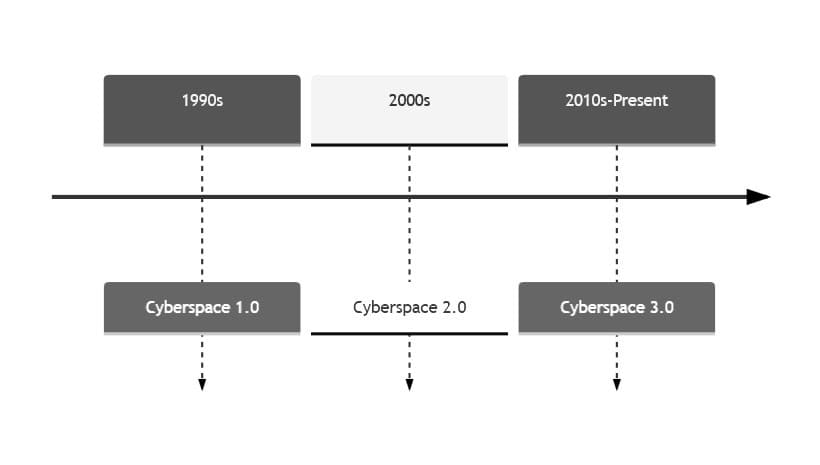1. Introduction
Initially conceived by William Gibson in his novel Neuromancer, cyberspace is now a real thing.
This virtual environment can be defined as an interconnected computer network powered by digital technologies. It’s present in most people’s daily lives, including communication, business, entertainment, and learning.
In this tutorial, we’ll consider a theoretical analysis of cyberspace, its key elements, and its applications in the real world.
2. Nature of Cyberspace
Cyberspace is a medium for creating, communicating, storing, and processing information. It’s integrated into the Internet and other telecommunication networks to facilitate global data flow.
It’s an environment unconstrained by geographical or other physical limitations. Its ‘frontiers’ depend on technological advancements.
It has several key components:
- Computer networks such as LANs, WANs, and the Internet form the fundamental basis of cyberspace. These networks enable the transfer of information between devices and their users
- Data, including text files, videos, sounds, images, and other content. Information is stored in data centers, cloud services, and personal devices. It can be accessed, used, and transformed in real time
- Infrastructure comprising servers, routers, switches, and other applications and platforms. Such an infrastructure makes producing, organizing, and distributing digital content possible
Finally, we have users who interact with systems and other users, having various online identities, such as e-mail addresses and social network accounts. These virtual identities facilitate communication, business, and partnership within the online environment.
3. Evolution
Cyberspace has evolved in three phases:

Cyberspace 1. 0 was characterized by little interactivity and mainly involved static web pages. At the time, it was a new phenomenon that was understood as separate from physical reality.
Then, cyberspace 2. 0 saw the increasing popularity of social networks, online stores, and web applications. It highlighted the interconnectivity of cyberspace with daily life.
Cyberspace 3. 0 is the current phase. It’s characterized by the Internet of Things (IoT), augmented reality (AR), and extensive connectivity with physical reality.
4. Technical Aspects
On the Internet, the connected systems and structures work under technical protocols. The primary protocol is TCP/IP (Transmission Control Protocol/Internet Protocol).
TCP ensures the data gets through the networks. IP provides distinct addresses for the devices to interact and exchange data through the internet network.
Augmented reality (AR) enhances interaction by integrating content into the user environment. It’s quickly transforming sectors such as education, gaming, retail, and healthcare. For example, it enables customers to inspect a product from their homes before purchasing. Further, in healthcare, AR is used for simulated surgeries and immediate assistance.
The Internet of Things (IoT) is a system of various devices that can communicate and exchange information. IoT extends cyberspace from the virtual to the physical environment. Thanks to IoT, we can develop smart houses, wearable electronics, and advanced industrial solutions.
5. Applications
Cyberspace has become a part of many aspects of daily life.
5.1. E-commerce and Marketing
E-commerce has emerged as one of cyberspace’s most revolutionary and dynamic uses.
Companies like Amazon use the digital world to offer friendly shopping experiences to their customers.
An e-commerce platform uses various marketing techniques. Sophisticated recommendation systems show products to buyers most likely to be interested in them, which also improves the buyers’ shopping experience.
5.2. Financial Transactions
E-commerce platforms use credit cards, payment gateways, and digital wallets for financial transactions.
Encryption and tokenization technologies help protect payment information, improving loyalty among consumers and merchants.
5.3. Supply Chain Management
Cyberspace plays a crucial role in supply chain management.
Real-time tracking solutions based on the Internet of Things track the movement of goods. As a result, we improve inventory control, minimize delays, and increase customer satisfaction.
5.4. Chat Applications
Live chat applications consist of instant messaging programs, customer support, or chatbots.
These tools rely on artificial intelligence to provide standard answers to questions. They can also recommend products and handle complaints.
5.5. Data Analytics and Consumer Insights
Various e-commerce platforms incorporate data analytical models to determine consumer insights.
Marketing initiatives based on machine learning deliver personalized messages to the target audience to boost conversions.
6. Structural View of Cyberspace
The diagram below illustrates the key components, uses, and technical aspects of cyberspace:

We have classified the core elements and their interactions with applications, use cases, and technology. The relationships between the subgraphs show how different components are related.
Networks play a part in communication, business, entertainment, and learning. Data and information also relate to these applications, highlighting the centrality of information flow. Digital infrastructure, users, and digital identities are associated with e-commerce and social media. This shows their relevance in these use cases.
Technical aspects outline TCP/IP, IoT, and AR, which are critical in the development and functioning of cyberspace.
7. Conclusion
In this article, we explained the term cyberspace. It’s a digital world focused on information sharing, economic activity, entertainment, and education.
Since its emergence, cyberspace has gone through three stages, improving its interactivity and immersion in physical space. Its components involve computer networks, storage, structures, and users, which work through protocols such as TCP/IP. E-commerce is an excellent example of its application.